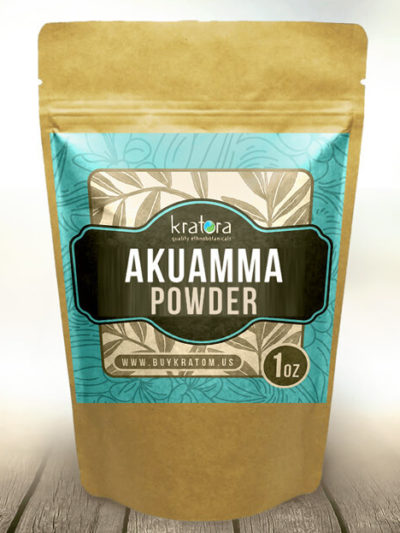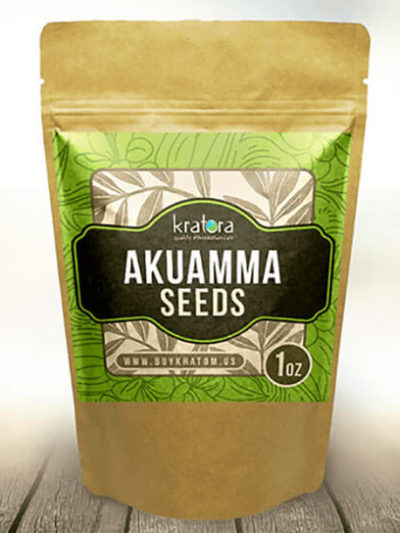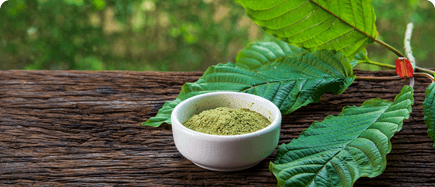Throughout tropical West Africa, a shrub-like tree can be found that is known to the locals as “Akuamma” and to the international community as vincamajordine or Picralima nitida.The seeds of this tree (found in our Akuamma collection) have been used in folk medicine for a long time in Ghana, Cameroon, Congo, Zaire, and Côte d’Ivoire. However, now that Akuamma powder is becoming more famous worldwide, many people are wondering what Akuamma is and what the effects of Akuamma vs. kratom may be.
Learning What is Akumma: The Akuamma Tree
Similar to kratom, the Akuamma plant is an understory rainforest tree that grows in the wild and flourishes along the riverbanks. The tree grows to a similar height as kratom as well, with a maximum height of 35 meters or 100 feet (although, in reality, Akuamma, is often much shorter than this maximum).
The difference between Akuamma vs. kratom in terms of their biology is that Akuamma produces flowers and seed-filled fruit all year round—which are the main parts of the plant that are used for medicinal purposes by locals, in addition to the bark and roots. In the case of kratom, the leaves are the part of the plant that is used medicinally.
What is the Traditional Akuamma Preparation Method?
In its native context, every part of the Akuamma tree is used for different purposes. Considering Akuamma vs. kratom, this is like using the stem and vein as well as the leaf when using kratom. Here are just a few examples of how locals prepare and use the various parts of the Picralima nitida tree:
The Seeds
When the Akuamma fruits are ripe, they are harvested by hand and sliced open. Harvesters extract the seeds manually and dry them in the sun to be chewed whole or ground into a powder. This is similar to the way that kratom is harvested in the wild and the leaves dried for export.
Being the part of the plant with the highest concentration of alkaloids, the dried Akuamma seeds are traditionally used as a gentle stimulant and remedy for:
- Fever
- Malaria, vomiting, and diarrhea
- Chronic pain
- Chest and respiratory problems
- Intestinal worms
When prepared as a poultice, the powdered seeds are used externally on abscesses. Thinking about Akuamma vs. kratom, both plants have a range of internal and external uses in their original contexts, and both are thought to be helpful remedies for fever and diarrhea.
-
Relaxing
Akuamma Powder
From $11.99 Shop Now This product has multiple variants. The options may be chosen on the product page Quick View -
Relaxing
Akuamma Whole Seeds
From $7.99 Shop Now This product has multiple variants. The options may be chosen on the product page Quick View
The Bark
Similar to the seeds, Akuamma bark is traditionally used for fever (including yellow fever), jaundice, and intestinal parasites.
The Root
In local cultures, when prepared as a decoction, the Akuamma root is taken for jaundice, fevers, pneumonia, and as a vermifuge (a substance that deals with intestinal worms).
The Leaves
A decoction of the leaves is traditionally taken for measles and guinea worm, with the leaf sap being used for otitis (ear infections), and as well as an external lotion for the measles.
The Fruit
A decoction is taken for coughs and fevers (including typhoid fever). Small amounts of the fruit and bark are sometimes chewed to stave off hunger during long treks through the bush. When thinking of Akuamma vs. kratom, this is similar to the way kratom is used by laborers in Southeast Asia.
What is Akuamma Used for Besides Medicine?
Apart from being used medicinally, the various parts of the Akuamma tree (seeds, roots, and fruit) are used by locals for other purposes as well. The seeds, roots, and fruits are used to make arrow and fish poison, while the fruit shell and yellow wood are used to make everyday items such as spoons, combs, and tools.
Akuamma vs. Kratom
While they originate from different world regions, Akuamma and kratom have become known on a global scale at around the same time and have fairly similar effects.
In general, when looking at Akuamma vs. kratom, both of these plants are said to provide natural stimulation and temporary relief from discomfort. Another similarity is that both of these plants grow in the wild and have traditionally been used by local communities for fever and diarrhea.
The main difference between Akuamma vs. kratom—as observed by users—is that kratom’s effects appear to be much stronger and longer-lasting than those of Akuamma. For these reasons, if kratom is illegal in your country or state, Akuamma could be a useful kratom alternative.
What is Akuamma’s Potential for Use in Western Medicine?
When comparing Akuamma vs. kratom, we can also look at their primary alkaloids. Both of these plants contain alkaloids that bind to opioid receptors in the brain—making them of interest to those seeking natural pain relief. Studies are continuing to come out explaining the action of these alkaloids in more detail and which preparation methods and dosages are the most effective.
Primary Alkaloids
The most abundant alkaloid in Akuamma is akuammine, which is thought to play a role in the plant’s pain-killing effects at both the local and general levels.
Other notable alkaloids in the plant and their effects include:
- Akuammidine—local and general (skeletal) analgesic, hypotensive
- Akuammicine—acts on the kappa-opioid receptors
- Akuammigine—protective against the effects of adrenaline
- Pseudo-akuammigine—supports the parasympathetic nervous system, anti-inflammatory, hypotensive
- Pericine—binds to mu-opioid receptors
- Alstonine—antipsychotic
Comparing Akuamma vs. kratom, we can see that they contain completely different alkaloids. However, the structure and behavior of those alkaloids in some cases seem to be similar.
Directions for Research
While it is not yet clear exactly how each of the compounds contributes to Akuamma’s folk medicinal effects, one study shows that several alkaloids from the P. nitida plant activate mu-, delta-, and kappa-opioid receptors in the body—making this plant of special interest to those seeking temporary relief from discomfort. Akuamma plant extracts are also being studied for their potential effects on blood sugar, malaria, parasites, and pyrexia.
What is the Best Akuamma to Buy?
If you happen to live in tropical West Africa, you might be able to find and purchase fresh Akuamma seeds at a local market. Otherwise, the best Akuamma seeds to buy are high-quality, fresh seeds from online vendors. At Kratora, we stock all-natural Akuamma seeds in their whole and powdered forms and are proud to offer you a product that is fresh and ethically sourced.
On our website, you can browse our premium ethnobotanicals by product, aroma, and world region. Shop Akuamma today to see which is your favorite between Akuamma vs. kratom, and receive same-day shipping on orders submitted before 3 PM EST Monday through Friday and 1 PM EST on Saturdays (excluding holidays).
Please note that none of the products sold on our website are intended to diagnose, treat, cure, or prevent any disease or medical condition.
Please note that the US FDA has not approved this product to be sold for human consumption, sold for external use only. None of the products sold on our website are intended to diagnose, treat, cure, or prevent any disease or medical condition.
Want to learn more about kratom quality and value? Start here:
Why Buying Cheap Kratom Can Be Dangerous






Just wanted to let the author of this article know how helpful and informative this was to me.. fantastic work explaining the difference between akuamma and keaton..
I want to try this! What should I order??
Thank you for visiting our site! At Kratora, you can find whole akuamma seeds and akuamma powder. You can visit the page of each product to find out which one should fit you better.
At Kratora, you will find a great variety of payment options, free priority shipping on domestic orders over $50, and a generous rewards program for our registered users. Please feel free to contact us at [email protected] if you need help.